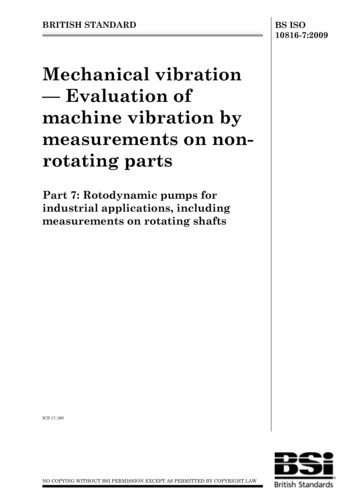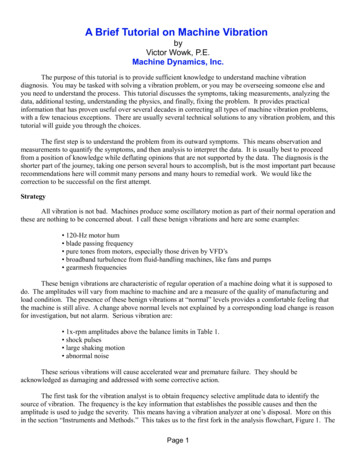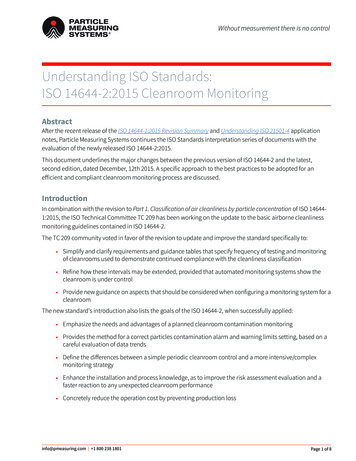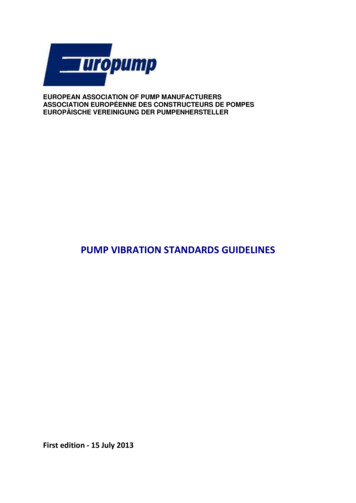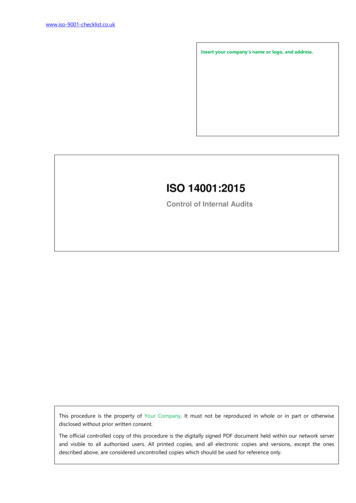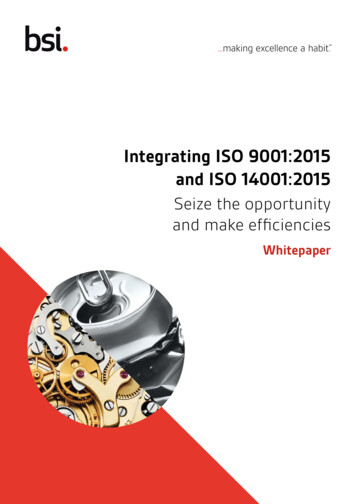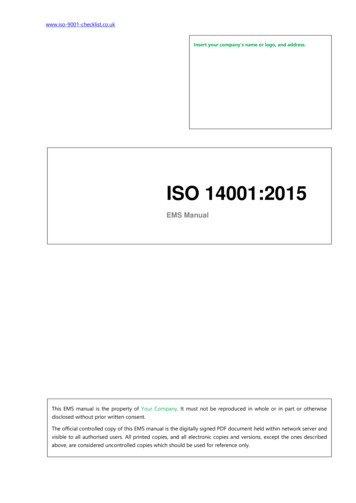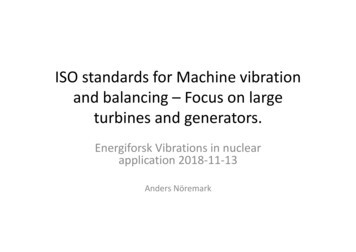
Transcription
ISO standards for Machine vibrationand balancing – Focus on largeturbines and generators.Energiforsk Vibrations in nuclearapplication 2018‐11‐13Anders Nöremark
ISO standards for Machine vibration andbalancing – Focus on large turbines andgenerators.1.2.3.4.IntroductionWhat is ISO ,TC 108, SC2 WG1,WG31 and SISVibration standards– Introduction– New numbering of vibration standards and what is new.– Most important for large steam turbines and generators ISO 20816‐2– Information about other relevant standards for power plantsBalancing and balancing standards.– Introduction– New numbering of balancing standards and what is new.– Most important for large steam turbines and generators ISO 21940‐11Rigid rotors and 21940‐12 Flexible rotors– Information about other relevant standards2018‐11‐13Energiforsk Vibration in nuclear application2018, ISO‐standards Anders Nöremark2
Do we need standards?Vibration standards Easier to share experiences with others.Easier to compare measurement values with otherSimplifies contract writingFacilitates acceptance test2018‐11‐13Energiforsk Vibration in nuclear application2018, ISO‐standards Anders Nöremark3
Do we need standards ?Balancing standards Makes it easier (possible) to build a complete machine fromcomponents from different manufacturer e.g. turbine‐generator, motor‐gearbox‐compressor, motor‐coupling‐pump. Facilitate discussion between customer and manufacturer– facilitate writing of specifications(for customer)– makes it easier for a manufacturer to explain balancingprocedure and criteria– facilitate customer control of balancing Good balancing standards will result in an improved qualityof balancing and that will result in improved vibrationbehaviour of machines in situ2018‐11‐13Energiforsk Vibration in nuclear application2018, ISO‐standards Anders Nöremark4
ISO Organization and general information. International Organization for Standardization develop andpublish International Standards. ISO standards respond to a need in the market ISO standards are based on global expert opinion ISO standards are based on a consensus2018‐11‐13Energiforsk Vibration in nuclear application2018, ISO‐standards Anders Nöremark5
ISO history 1947 the new organization, ISO, officially began operations ISO/TC 108, Mechanical vibration, shock and conditionmonitoring, 1956? Subcommittee SC 2, Measurement and evaluation ofmechanical vibration and shock as applied to machines,vehicles and structures. 1963 ISO 1940 Rigid rotors Published 1973 (SC 1) ISO 2372 Mechanical vibration of machines with operatingspeeds from 10 to 200 rev/s Published 19742018‐11‐13Energiforsk Vibration in nuclear application2018, ISO‐standards Anders Nöremark6
SIS, Swedish Standards InstituteSIS, Swedish Standards InstituteBox 45443, 104 31 Stockholm08‐555 520 00info@sis.seSIS/TK 111 AG2Project manager Lisa Almkvist 08‐55552115lisa.almkvist@sis.seChairman Björn Larsson Siemens, Finspång2018‐11‐13Energiforsk Vibration in nuclear application2018, ISO‐standards Anders Nöremark7
Vibration Standards history Rathbone 1939 DIN VDI 2056 Bearing vibration 1957 DIN VDI 2059 Shaft vibration 1972 ISO 2372 Bearing vibration 1974 ISO 3545 Bearing vibration Large machines 1977 ISO 7919 Shaft vibration 1986 ISO 10816 Bearing vibration 1995 ( replaced 2372 and 3945) Manyparts ISO 20816 Bearing and Shaft Vibration 2016 (merge of 7919 and10816)2018‐11‐13Energiforsk Vibration in nuclear application2018, ISO‐standards Anders Nöremark8
“Standard” Rathbone 19397.1 mm/s2.8 mm/s2018‐11‐13Energiforsk Vibration in nuclear application2018, ISO‐standards Anders Nöremark9
ISO Vibration standards today ISO 10816‐ Bearing vibration ISO 7919‐ Shaft vibration ISO 20816‐ New series bearing and shaft vibration.Merge of 10816 and 7919 to 20816.Important for power plants. ISO 20816 ‐2 Land‐based gas turbines, steamturbines and generators in excess of 40 MW, withfluid‐film bearings and rated speeds of 1 500 r/min,1800 r/min, 3 000 r/min and 3 600 r/min.2018‐11‐13Energiforsk Vibration in nuclear application2018, ISO‐standards Anders Nöremark10
ISO Vibration standards Change numbering The old series ISO10816(bearing vibration) and ISO7919(shaftvibration) have or will be changed to ISO 20816( bearing andshaft vibration)What is new in 20816‐2 and 20816‐4 ISO 20816‐2 includes gas turbines over 40 MW. ISO 10816‐4 includes gas turbines between 3MW and 40 MWand gas turbines with operating speeds other than1500,1800,3000 and 3600 RPM2018‐11‐13Energiforsk Vibration in nuclear application2018, ISO‐standards Anders Nöremark11
ISO Vibration standards Status today 20816‐1 General guidelines (Published 2016) 20816‐2: Land‐based gas turbines, steam turbines and generators inexcess of 40 MW, with fluid‐film bearings and rated speeds of 1 500r/min, 1 800 r/min, 3 000 r/min and 3 600 r/min (2017) 10816‐3 Industrial machines with nominal power above 15 kW andnominal speeds between 120 r/min and 15 000 r/min whenmeasured in situ (Published 2009) Will be revised 7919‐3 Mechanical vibration — Evaluation of machine vibration bymeasurements on rotating shafts — Coupled industrial machines( Published2009) Will be revised 20816‐4 Gas turbines in excess of 3 MW, with fluid‐film bearings(Published 2018)2018‐11‐13Energiforsk Vibration in nuclear application2018, ISO‐standards Anders Nöremark12
ISO Vibration standards Status today ISO 20816‐ 5: Machine sets in hydraulic power generating andpumping plants (2018) ISO 10816‐6: Reciprocating machines with power ratingsabove 100 kW (1995) Part 7: Rotodynamic pumps for industrial applications,including measurements on rotating shafts (2009) Part 8: Reciprocating compressors 20142018‐11‐13Energiforsk Vibration in nuclear application2018, ISO‐standards Anders Nöremark13
20816‐1 General guidelinesFrom Scope This document establishes general conditions and procedures forthe measurement and evaluation of vibration using measurementsmade on rotating, non‐rotating and non‐reciprocating part ofcomplete machinesExample of contents Following measurement quantities can be used: a) vibration displacement, measured in micrometres;b) vibration velocity, measured in millimetres per second;c) vibration acceleration, measured in metres per square second. No vibration limits are presented in Part ‐12018‐11‐13Energiforsk Vibration in nuclear application2018, ISO‐standards Anders Nöremark14
20816‐1 General guidelinesFrom Scope a) structural vibration at all main bearing housings or pedestalsmeasured radial (i.e. transverse) to the shaft axis; b) structural vibration at thrust bearing housings measured in theaxial direction; c) vibration of rotating shafts radial (i.e. transverse) to the shaft axisat, or close to, the main bearings. These are in terms of the following: — vibration under normal steady‐state operating conditions; — vibration during other (non‐steady‐state) conditions whentransient changes are taking place, including run up or run down,initial loading and load changes; — changes in vibration which can occur during normal steady‐stateoperation.2018‐11‐13Energiforsk Vibration in nuclear application2018, ISO‐standards Anders Nöremark15
20816‐1 Positions for measurements onrotating shafts2018‐11‐13Energiforsk Vibration in nuclear application2018, ISO‐standards Anders Nöremark16
ISO 20816‐1 Evaluation zones The following evaluation zones are defined topermit a qualitative assessment of thevibration on a given machine under steady‐state conditions at normal operating speedand to provide guidelines on possible actions.Different categorization and number of zonesmay apply for specific machine types. Theseare provided in additional parts of ISO 20816.2018‐11‐13Energiforsk Vibration in nuclear application2018, ISO‐standards Anders Nöremark17
ISO 20816‐1 Evaluation zones Zone A: The vibration of newly commissioned machinesnormally falls within this zone.NOTE The effort required to achieve vibration within zone Acan be disproportionate and unnecessary. Zone B: Machines with vibration within this zone are normallyconsidered acceptable for unrestricted long‐term operation.2018‐11‐13Energiforsk Vibration in nuclear application2018, ISO‐standards Anders Nöremark18
ISO 20816‐1 Evaluation zones Zone C: Machines with vibration within this zone are normallyconsidered unsatisfactory for long‐term continuous operation.Generally, the machine may be operated for a limited period in thiscondition until a suitable opportunity arises for remedial action.Zone D: Vibration values within this zone are normally considered tobe of sufficient severity to cause damage to the machine.2018‐11‐13Energiforsk Vibration in nuclear application2018, ISO‐standards Anders Nöremark19
ISO 20816‐2 Land‐based gas turbines, steamturbines and generators in excess of 40 MWTitlePart 2:INTERNATIONAL STANDARD ISO 20816‐2:2017(E)Mechanical vibration — Measurement and evaluation ofmachine vibration —Land‐based gas turbines, steam turbines and generators inexcess of 40 MW, with fluid‐film bearings and rated speeds of 1500 r/min, 1 800 r/min, 3 000 r/min and 3 600 r/min2018‐11‐13Energiforsk Vibration in nuclear application2018, ISO‐standards Anders Nöremark20
ISO 20816‐2 Land‐based gas turbines, steam turbinesand generators in excess of 40 MWFrom Scope This document is applicable to land‐based gasturbines, steam turbines and generators (whethercoupled with gas and/or steam turbines) with poweroutputs greater than 40 MW, fluid‐film bearings andrated speeds of 1 500 r/min, 1 800 r/min, 3 000r/min or 3 600 r/min.2018‐11‐13Energiforsk Vibration in nuclear application2018, ISO‐standards Anders Nöremark21
ISO 20816‐2 Frequency range The measurement system shall for structural vibration becapable of measuring broad‐band vibration over a frequencyrange from 10 Hz to at least 500 Hz and for shaft vibration1Hz to at least three times the maximum normal operatingfrequency or 125 Hz, whichever is greater .2018‐11‐13Energiforsk Vibration in nuclear application2018, ISO‐standards Anders Nöremark22
ISO 20816‐2 Typical measuring points anddirection steam turbine bearing2018‐11‐13Energiforsk Vibration in nuclear application2018, ISO‐standards Anders Nöremark23
ISO 20816‐2 Typical measuring points anddirection a gasturbine bearing2018‐11‐13Energiforsk Vibration in nuclear application2018, ISO‐standards Anders Nöremark24
ISO 20816‐2 Evaluation zone boundariesfor vibration of non‐rotating partsZone A: The vibration of newly commissionedmachines normally falls within this zoneZone B: Acceptable for unrestrictedlong‐term operation.2018‐11‐13— Zone C: Unsatisfactory for long‐ termcontinuous operation. Zone D: sufficient severity to cause damageto the machine.Energiforsk Vibration in nuclear application2018, ISO‐standards Anders Nöremark25
ISO 20816‐2 Evaluation zone boundariesfor vibration of rotating shaftsZone A: The vibration of newly commissioned — Zone C: Unsatisfactory for long‐ termmachines normally falls within this zonecontinuous operationZone B: Acceptable for unrestrictedlong‐term operation.2018‐11‐13 Zone D: Vibration values within this zoneare normally considered to be of sufficientseverity to cause damage to the machine.Energiforsk Vibration in nuclear application2018, ISO‐standards Anders Nöremark26
ISO 20816‐2 Alarm limit during runup, run down and overspeed2018‐11‐13Energiforsk Vibration in nuclear application2018, ISO‐standards Anders Nöremark27
ISO 20816‐2 Acceptance criteria Acceptance criteria should always be subject toagreement between the machine supplier and purchaser The evaluation zones provide a basis for definingacceptance criteria but the numerical are not intendedto serve as acceptance specifications. Historically, for new machines, acceptance criteria havebeen specified in zone A or zone B, but would normallynot exceed 1,25 times the zone A/B boundary.2018‐11‐13Energiforsk Vibration in nuclear application2018, ISO‐standards Anders Nöremark28
ISO 20816‐2 Setting of ALARMS The ALARM limits can vary for individual machines. It isrecommended that the values chosen should normallybe set relative to baseline values determined fromexperience for the measurement position or directionfor that particular machine. It is recommended that the ALARM limit be set higherthan the baseline by an amount equal to 25 % of thezone boundary B/C. The ALARM limit should notnormally exceed 1,25 times the zone boundary B/C.2018‐11‐13Energiforsk Vibration in nuclear application2018, ISO‐standards Anders Nöremark29
ISO 20816‐2 Setting of TRIPS The TRIP limits generally relate to the mechanical integrity ofthe machine and are dependent on any specific designfeatures which have been introduced to enable the machineto withstand abnormal dynamic forces.2018‐11‐13Energiforsk Vibration in nuclear application2018, ISO‐standards Anders Nöremark30
ISO 20816‐2 Setting of TRIPS It is not possible to give more precise guidelines for absoluteTRIP limits. In general, the TRIP limit is within zone C or D, butit is recommended that it not exceed 1,25 times the zoneboundary C/D.2018‐11‐13Energiforsk Vibration in nuclear application2018, ISO‐standards Anders Nöremark31
ISO 10816‐3 Industrial machinesmeasurements on non‐rotating parts Industrial machines with nominal powerabove 15 kW and nominal speeds between120 r/min and 15 000 r/min when measuredin situ2018‐11‐13Energiforsk Vibration in nuclear application2018, ISO‐standards Anders Nöremark32
ISO 10816‐3 Industrial machinesmeasurements on non‐rotating parts The machine sets covered by this part of ISO 10816include:steam turbines with power up to 50 40 MW; steam turbine sets with power greater than 5040MW and speeds below 1 500 r/min or above 3 600r/min (not included in ISO 10816‐2);rotary compressors; industrial gas turbines with power up to 3 MW; generators; electrical motors of any type; blowers or fan
ISO 10816‐3 Industrial machines measurementson non‐rotatingparts The machinesets coveredby thispart ofISO 10816 include: steamturbineswithpowerupto 5040 MW; steamturbinesets withpowergreaterthan50 40MW and speeds below1 500 r/min or File Size: 1MBPage Count: 86

